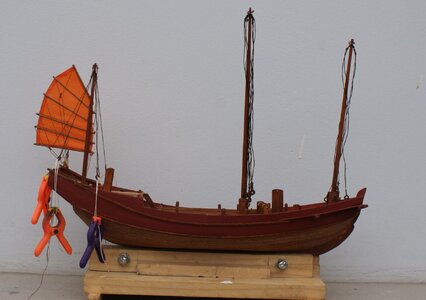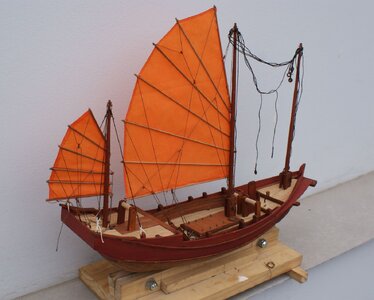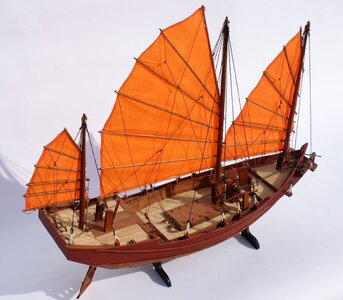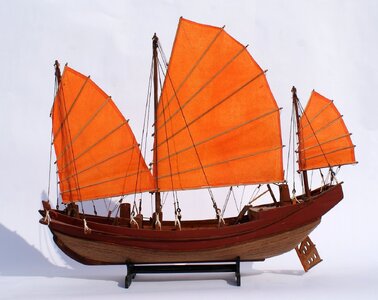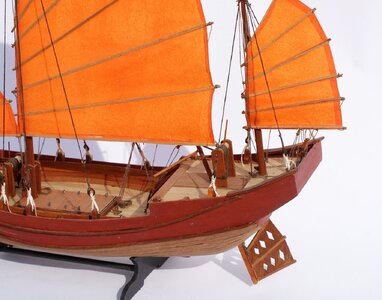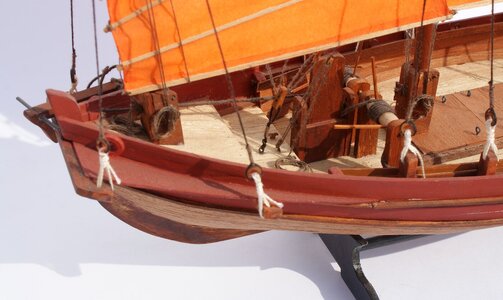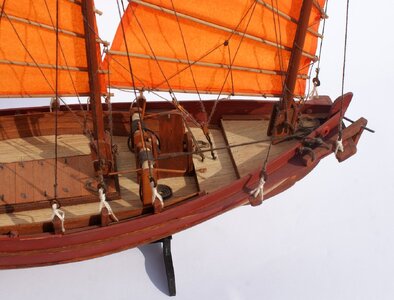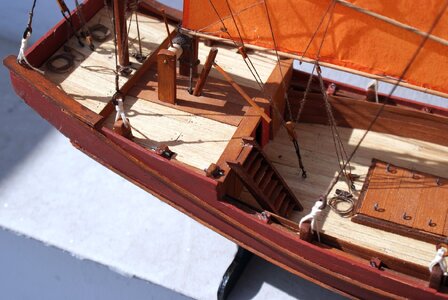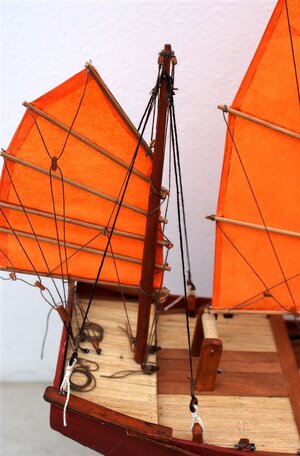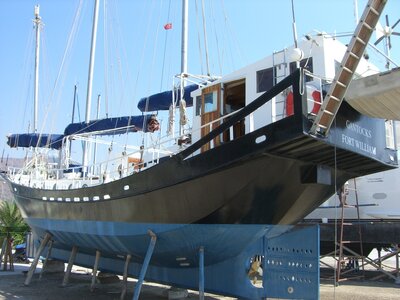Vietnamese Junk, Scratch built, Scale 1:75 (COMPLETED)
Now, I present something different, a junk (Dzonka, Junk, Junco), the model and the work do not require great techniques, but I thought it was fun to make a boat with lines different from the western ones.
Vietnamese Junk (Part 1 of 2)
The paragraphs in quotation marks have been taken from the references indicated.
“In the 9th century AD, Chinese junks transported goods to Indonesia and India. During the 15th century, junks already sailed to East Africa. Their sails are made of thick fabric joined together, the rudder is removable and higher than in common boats, which allowed them to navigate in shallow waters.” . “Their hull is divided longitudinally and transversely by bulkheads or solid wooden planks, thus forming watertight or hermetic compartments. These bulkheads, which were not adopted in the West until the 19th century, not only provide structural rigidity to the ship but also protect it against possible sinking. The lack of a keel is compensated for by a heavy rudder, mounted on the central axis through a watertight housing in the bottom.”
“The junks had several characteristics that made them easy to identify, although in the images or records obtained not always all of them can be distinguished. They were usually huge, with a flat hull, with greater width in the center, a thin bow and carried sails very different from those of the West, since many were square and had a reticular or slatted structure (similar to blinds).”
“Other distinctive features were the projecting stern castle with a gunwale, a setback at the rudder level, a small protected tower, a slightly oblique keel, with the poop decks and cabins in the stern. They usually carried three large masts, but there are reports that Zheng He's fleet had junks with up to 9 masts. They traveled to India and the Persian Gulf on trade missions. It was also a favorite vessel for East Indian pirates.”
“Although it has long been customary to call all Chinese ships junks, as a generic term, research is now providing enough knowledge to distinguish them. In fact, today we know that the junk could be made in different sizes, so it is possible to find large ships like those in Zheng He's treasure fleet and also smaller ones for fishing and passenger transport, and they are all junks.”
2. References

 blogcatedranaval.com
blogcatedranaval.com

 en.wikipedia.org
en.wikipedia.org
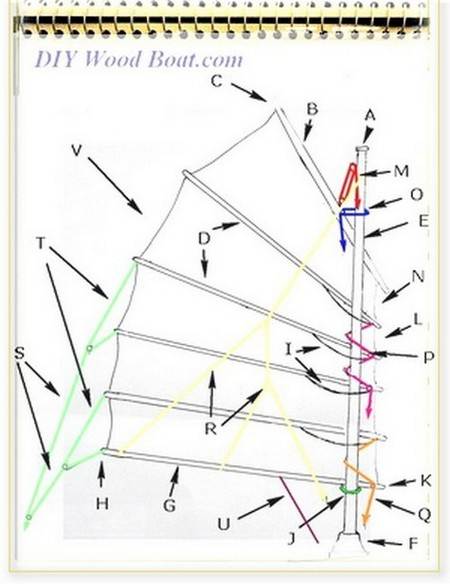
 www.diy-wood-boat.com
There are several plans for kit models of well-known brands on the market, but a model entitled “Dzonka Vietnamu” – Skala 1:200 was chosen, obtained from the article “Dzonka Wietnamska – Tadeus Piskorzyrisk” Modelarz Magazine, October 1984.
www.diy-wood-boat.com
There are several plans for kit models of well-known brands on the market, but a model entitled “Dzonka Vietnamu” – Skala 1:200 was chosen, obtained from the article “Dzonka Wietnamska – Tadeus Piskorzyrisk” Modelarz Magazine, October 1984.
3. Model construction
From the plans shown and the hull lines, the sections for the frames, the shape of the deck and the dimensions of the mast were obtained. It was drawn in AutoCAD and the frames and main parts were laser cut from 4 mm and 1.5 mm plywood sheets. The dimensions of minor elements were taken to scale from the plans and photographs of similar ships.
The pictures show the planks and the first part of the frame assembly. Balsa wood fillers were placed on the bow and stern to enable the hull to be given the proper shape. 2x5 mm strakes were placed and then a mixture of putty, sawdust and white glue was prepared to fill the joints and deficiencies of the first skin. After sanding, the topsides were painted with ochre-coloured paint and the bottom was covered with 0.5x5 mm zapelli strips which were darkened with very diluted opaque varnish and sanded.
The shape of the deck had to be rectified and the planking was prepared on it with 0.5x9mm strips, placed in a three-by-three arrangement, the nailing was simulated and aged with Judea bitumen. Then the deck elements such as the entrance to the hold, winches, centreboard, bitts, masts, etc. were placed. The dimensions of the sails were taken, which were made with tissue paper, applying orange acrylic paint on both sides, to give it firmness. The boom and intermediate rods or battens were glued on them and before mounting them, all the tacks and blocks were fixed to the sail.
The sails were mounted with all their elements on the masts, as well as all the running rigging. The mizzen was started with, the main mast then the foremast. The shrouds were placed with thicker thread.
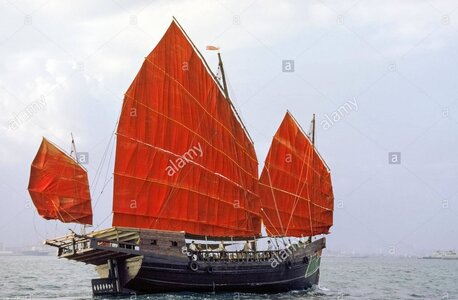
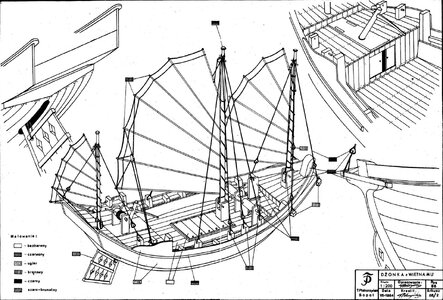
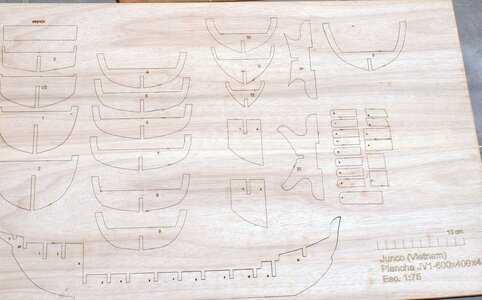
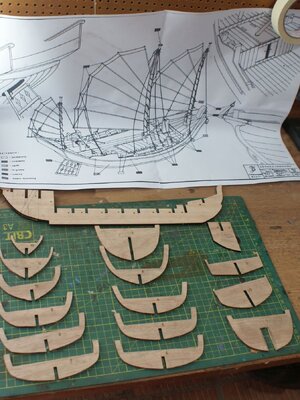
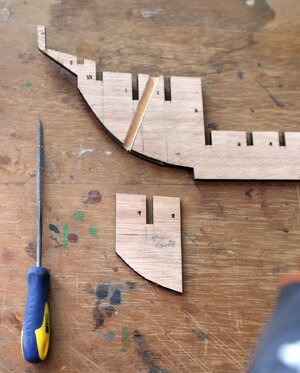
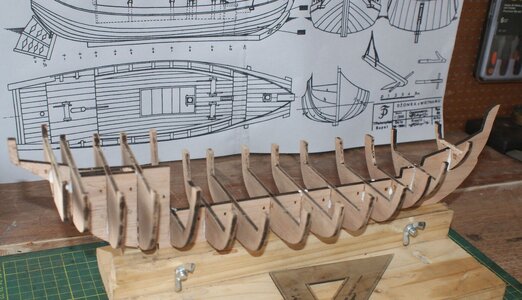
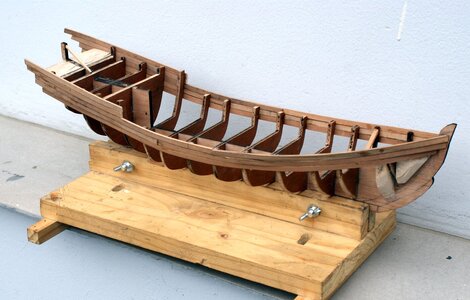
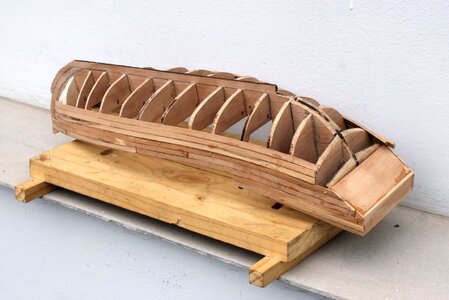
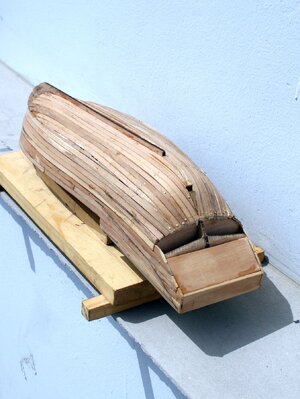
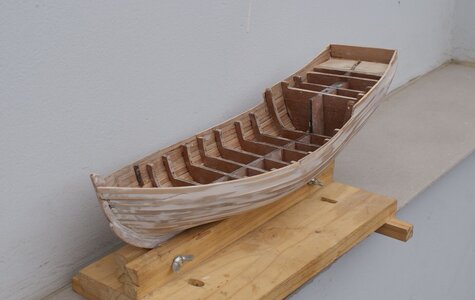
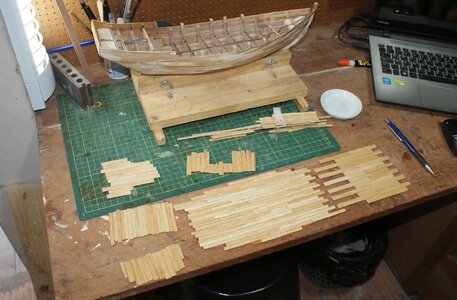
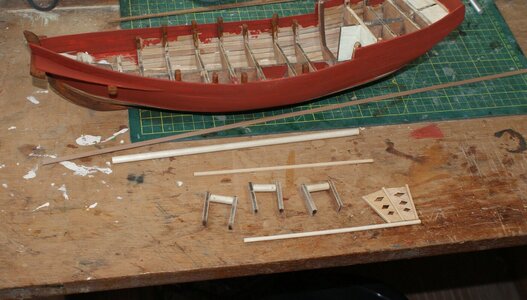
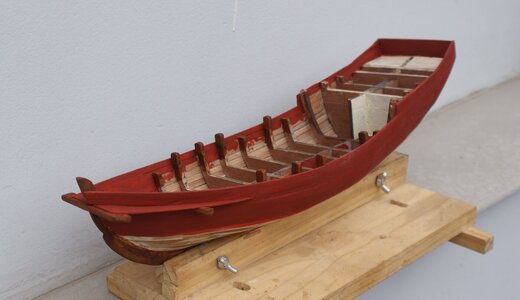
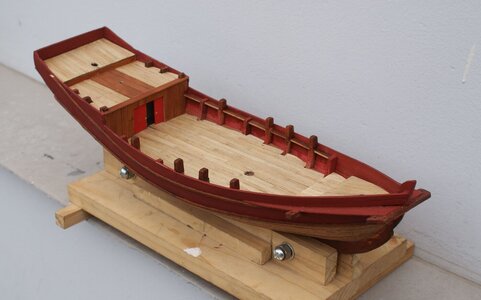
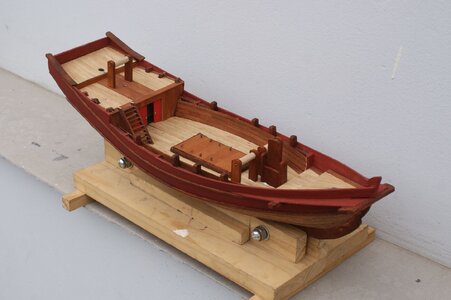
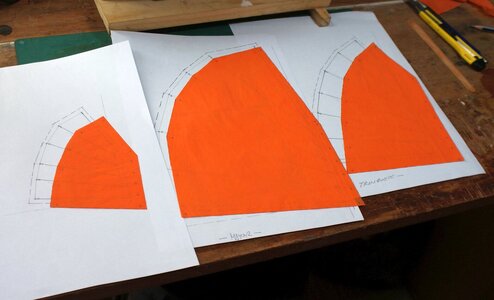
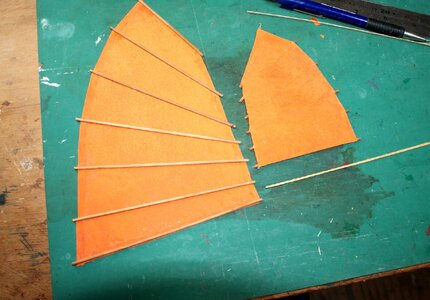
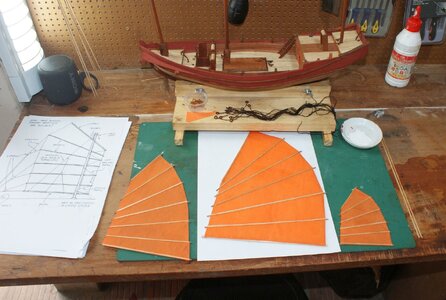
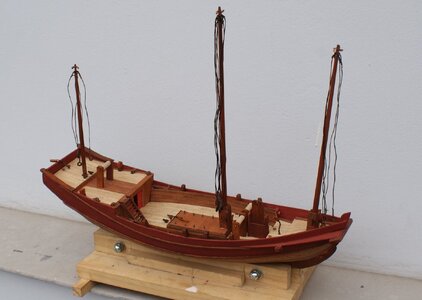
Now, I present something different, a junk (Dzonka, Junk, Junco), the model and the work do not require great techniques, but I thought it was fun to make a boat with lines different from the western ones.
Vietnamese Junk (Part 1 of 2)
The paragraphs in quotation marks have been taken from the references indicated.
“In the 9th century AD, Chinese junks transported goods to Indonesia and India. During the 15th century, junks already sailed to East Africa. Their sails are made of thick fabric joined together, the rudder is removable and higher than in common boats, which allowed them to navigate in shallow waters.” . “Their hull is divided longitudinally and transversely by bulkheads or solid wooden planks, thus forming watertight or hermetic compartments. These bulkheads, which were not adopted in the West until the 19th century, not only provide structural rigidity to the ship but also protect it against possible sinking. The lack of a keel is compensated for by a heavy rudder, mounted on the central axis through a watertight housing in the bottom.”
“The junks had several characteristics that made them easy to identify, although in the images or records obtained not always all of them can be distinguished. They were usually huge, with a flat hull, with greater width in the center, a thin bow and carried sails very different from those of the West, since many were square and had a reticular or slatted structure (similar to blinds).”
“Other distinctive features were the projecting stern castle with a gunwale, a setback at the rudder level, a small protected tower, a slightly oblique keel, with the poop decks and cabins in the stern. They usually carried three large masts, but there are reports that Zheng He's fleet had junks with up to 9 masts. They traveled to India and the Persian Gulf on trade missions. It was also a favorite vessel for East Indian pirates.”
“Although it has long been customary to call all Chinese ships junks, as a generic term, research is now providing enough knowledge to distinguish them. In fact, today we know that the junk could be made in different sizes, so it is possible to find large ships like those in Zheng He's treasure fleet and also smaller ones for fishing and passenger transport, and they are all junks.”
2. References

Los juncos en la historia marítima de Asia
Hay naves que unen historia, mito y leyenda, por lo que es difícil separar la realidad de la ficción. En el continente asiático, las embarcaciones conocidas como juncos son un buen ejemplo. Las cró…
 blogcatedranaval.com
blogcatedranaval.com

Junk (ship) - Wikipedia

Junk Rig the ideal cruising sail.
How to rig a western version of the Chinese Junk Rig the basic lines and controls.
3. Model construction
From the plans shown and the hull lines, the sections for the frames, the shape of the deck and the dimensions of the mast were obtained. It was drawn in AutoCAD and the frames and main parts were laser cut from 4 mm and 1.5 mm plywood sheets. The dimensions of minor elements were taken to scale from the plans and photographs of similar ships.
The pictures show the planks and the first part of the frame assembly. Balsa wood fillers were placed on the bow and stern to enable the hull to be given the proper shape. 2x5 mm strakes were placed and then a mixture of putty, sawdust and white glue was prepared to fill the joints and deficiencies of the first skin. After sanding, the topsides were painted with ochre-coloured paint and the bottom was covered with 0.5x5 mm zapelli strips which were darkened with very diluted opaque varnish and sanded.
The shape of the deck had to be rectified and the planking was prepared on it with 0.5x9mm strips, placed in a three-by-three arrangement, the nailing was simulated and aged with Judea bitumen. Then the deck elements such as the entrance to the hold, winches, centreboard, bitts, masts, etc. were placed. The dimensions of the sails were taken, which were made with tissue paper, applying orange acrylic paint on both sides, to give it firmness. The boom and intermediate rods or battens were glued on them and before mounting them, all the tacks and blocks were fixed to the sail.
The sails were mounted with all their elements on the masts, as well as all the running rigging. The mizzen was started with, the main mast then the foremast. The shrouds were placed with thicker thread.





















